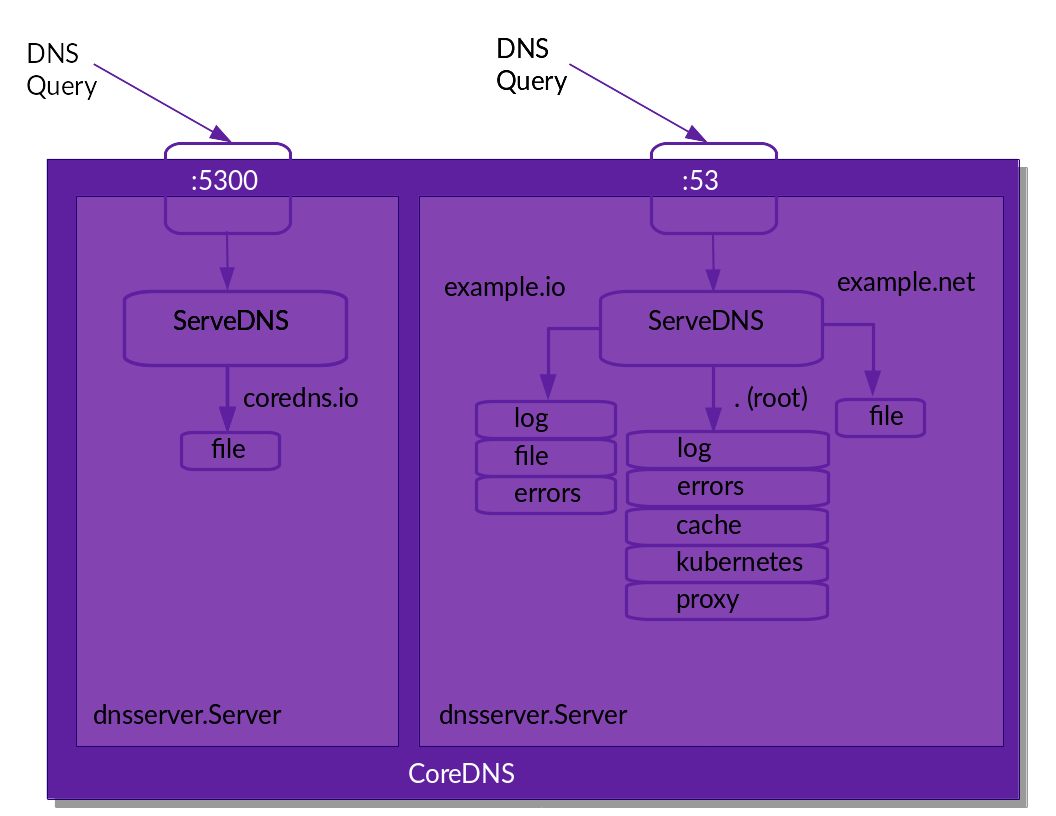Kubernetes部署coredns
Kubernetes基于DNS的服务发现
在Kubernetes集群推荐使用Service Name作为服务的访问地址,因此需要一个Kubernetes集群范围的DNS服务实现从Service Name到Cluster Ip的解析,这就是Kubernetes基于DNS的服务发现功能。
CoreDNS的架构

DNS 格式
1、service资源的DNS记录
A记录:<service>.<ns>.svc.<zone>.<ttl> IN A <cluster-ip>
my-svc.my-namespace.svc.cluster.local
SRV记录:_<port>._<proto>.<service>.<ns>.svc.<zone>.<ttl> IN SRV <weight><priority><port-number><service>.<ns>.svc.<zone>
_my-port-name._my-port-protocol.my-svc.my-namespace.svc.cluster.local
A记录:<service>.<ns>.svc.<zone>.<ttl> IN A <cluster-ip>
SRV记录:_<port>._<proto>.<service>.<ns>.svc.<zone>.<ttl> IN SRV <weight><priority><port-number><hostname>.<service>.<ns>.svc.<zone>
PTR记录:<d>.<c>.<b>.<a>.in-addr.arpa.<ttl> IN PTR <hostname>.<service>.<ns>.svc.<zone>
3、ExternalName类型的service资源,需要具有CNAME类型的资源记录
CNAME记录:<service>.<ns>.svc.<zone> IN CNAME <extname>
wget https://raw.githubusercontent.com/coredns/deployment/master/kubernetes/coredns.yaml.sed wget https://raw.githubusercontent.com/coredns/deployment/master/kubernetes/deploy.sh chmod +x deploy.sh ./deploy.sh -i 10.96.0.10 >coredns.yml kubectl apply -f coredns.yml
coredns.yml文件
apiVersion: v1 kind: ServiceAccount metadata: name: coredns namespace: kube-system --- apiVersion: rbac.authorization.k8s.io/v1 kind: ClusterRole metadata: labels: kubernetes.io/bootstrapping: rbac-defaults name: system:coredns rules: - apiGroups: - "" resources: - endpoints - services - pods - namespaces verbs: - list - watch - apiGroups: - discovery.k8s.io resources: - endpointslices verbs: - list - watch --- apiVersion: rbac.authorization.k8s.io/v1 kind: ClusterRoleBinding metadata: annotations: rbac.authorization.kubernetes.io/autoupdate: "true" labels: kubernetes.io/bootstrapping: rbac-defaults name: system:coredns roleRef: apiGroup: rbac.authorization.k8s.io kind: ClusterRole name: system:coredns subjects: - kind: ServiceAccount name: coredns namespace: kube-system --- apiVersion: v1 kind: ConfigMap metadata: name: coredns namespace: kube-system data: Corefile: | .:53 { errors health { lameduck 5s } ready kubernetes cluster.local in-addr.arpa ip6.arpa { fallthrough in-addr.arpa ip6.arpa } prometheus :9153 forward . /etc/resolv.conf { max_concurrent 1000 } cache 30 loop reload loadbalance } --- apiVersion: apps/v1 kind: Deployment metadata: name: coredns namespace: kube-system labels: k8s-app: kube-dns kubernetes.io/name: "CoreDNS" spec: # replicas: not specified here: # 1. Default is 1. # 2. Will be tuned in real time if DNS horizontal auto-scaling is turned on. strategy: type: RollingUpdate rollingUpdate: maxUnavailable: 1 selector: matchLabels: k8s-app: kube-dns template: metadata: labels: k8s-app: kube-dns spec: priorityClassName: system-cluster-critical serviceAccountName: coredns tolerations: - key: "CriticalAddonsOnly" operator: "Exists" nodeSelector: kubernetes.io/os: linux affinity: podAntiAffinity: preferredDuringSchedulingIgnoredDuringExecution: - weight: 100 podAffinityTerm: labelSelector: matchExpressions: - key: k8s-app operator: In values: ["kube-dns"] topologyKey: kubernetes.io/hostname containers: - name: coredns image: coredns/coredns:1.8.4 imagePullPolicy: IfNotPresent resources: limits: memory: 170Mi requests: cpu: 100m memory: 70Mi args: [ "-conf", "/etc/coredns/Corefile" ] volumeMounts: - name: config-volume mountPath: /etc/coredns readOnly: true ports: - containerPort: 53 name: dns protocol: UDP - containerPort: 53 name: dns-tcp protocol: TCP - containerPort: 9153 name: metrics protocol: TCP securityContext: allowPrivilegeEscalation: false capabilities: add: - NET_BIND_SERVICE drop: - all readOnlyRootFilesystem: true livenessProbe: httpGet: path: /health port: 8080 scheme: HTTP initialDelaySeconds: 60 timeoutSeconds: 5 successThreshold: 1 failureThreshold: 5 readinessProbe: httpGet: path: /ready port: 8181 scheme: HTTP dnsPolicy: Default volumes: - name: config-volume configMap: name: coredns items: - key: Corefile path: Corefile --- apiVersion: v1 kind: Service metadata: name: kube-dns namespace: kube-system annotations: prometheus.io/port: "9153" prometheus.io/scrape: "true" labels: k8s-app: kube-dns kubernetes.io/cluster-service: "true" kubernetes.io/name: "CoreDNS" spec: selector: k8s-app: kube-dns clusterIP: 10.96.0.10 ports: - name: dns port: 53 protocol: UDP - name: dns-tcp port: 53 protocol: TCP - name: metrics port: 9153 protocol: TCP
CoreDNS ConfigMap选项
Upstream 用于解析指向外部主机的服务(外部服务)。
- prometheus:CoreDNS的度量标准可以在http//localhost:9153/Prometheus格式的指标中找到。
- proxy:任何不在Kubernetes集群域内的查询都将转发到预定义的解析器(/etc/resolv.conf)。
- cache:这将启用前端缓存。
- loop:检测简单的转发循环,如果找到循环则停止CoreDNS进程。
- reload:允许自动重新加载已更改的Corefile。编辑ConfigMap配置后,请等待两分钟以使更改生效。
- loadbalance:这是一个循环DNS负载均衡器,可以在答案中随机化A,AAAA和MX记录的顺序。
测试
cat >busybox.yaml<<EOF apiVersion: v1 kind: Pod metadata: name: busybox namespace: default spec: containers: - name: busybox image: busybox:1.28 command: - sleep - "3600" imagePullPolicy: IfNotPresent restartPolicy: Always EOF
kubectl create -f busybox.yaml
kubectl get pods busybox
kubectl get pods busybox
kubectl exec busybox -- cat /etc/resolv.conf
[root@k8s-master coredns]# kubectl exec busybox -- cat /etc/resolv.conf
nameserver 10.96.0.10
search default.svc.cluster.local svc.cluster.local cluster.local
options ndots:5
kubectl exec -ti busybox -- nslookup kubernetes.default
[root@k8s-master coredns]# kubectl exec -ti busybox -- nslookup kubernetes.default
Server: 10.96.0.10
Address 1: 10.96.0.10 kube-dns.kube-system.svc.cluster.local
Name: kubernetes.default
Address 1: 10.96.0.1 kubernetes.default.svc.cluster.loca
# 在calico网络中也配置一个coredns# 10.96.0.10 为k8s官方指定的kube-dns地址mkdir coredns && cd coredns wget https://raw.githubusercontent.com/coredns/deployment/master/kubernetes/coredns.yaml.sed wget https://raw.githubusercontent.com/coredns/deployment/master/kubernetes/deploy.sh chmod +x deploy.sh ./deploy.sh -i 10.96.0.10 > coredns.yml kubectl apply -f coredns.yml# 查看kubectl get pods --namespace kube-system kubectl get svc --namespace kube-system
作者:慕码人8056858
链接:https://www.imooc.com/article/273941
来源:慕课网






【推荐】国内首个AI IDE,深度理解中文开发场景,立即下载体验Trae
【推荐】编程新体验,更懂你的AI,立即体验豆包MarsCode编程助手
【推荐】抖音旗下AI助手豆包,你的智能百科全书,全免费不限次数
【推荐】轻量又高性能的 SSH 工具 IShell:AI 加持,快人一步
· Linux系列:如何用heaptrack跟踪.NET程序的非托管内存泄露
· 开发者必知的日志记录最佳实践
· SQL Server 2025 AI相关能力初探
· Linux系列:如何用 C#调用 C方法造成内存泄露
· AI与.NET技术实操系列(二):开始使用ML.NET
· 被坑几百块钱后,我竟然真的恢复了删除的微信聊天记录!
· 没有Manus邀请码?试试免邀请码的MGX或者开源的OpenManus吧
· 【自荐】一款简洁、开源的在线白板工具 Drawnix
· 园子的第一款AI主题卫衣上架——"HELLO! HOW CAN I ASSIST YOU TODAY
· Docker 太简单,K8s 太复杂?w7panel 让容器管理更轻松!